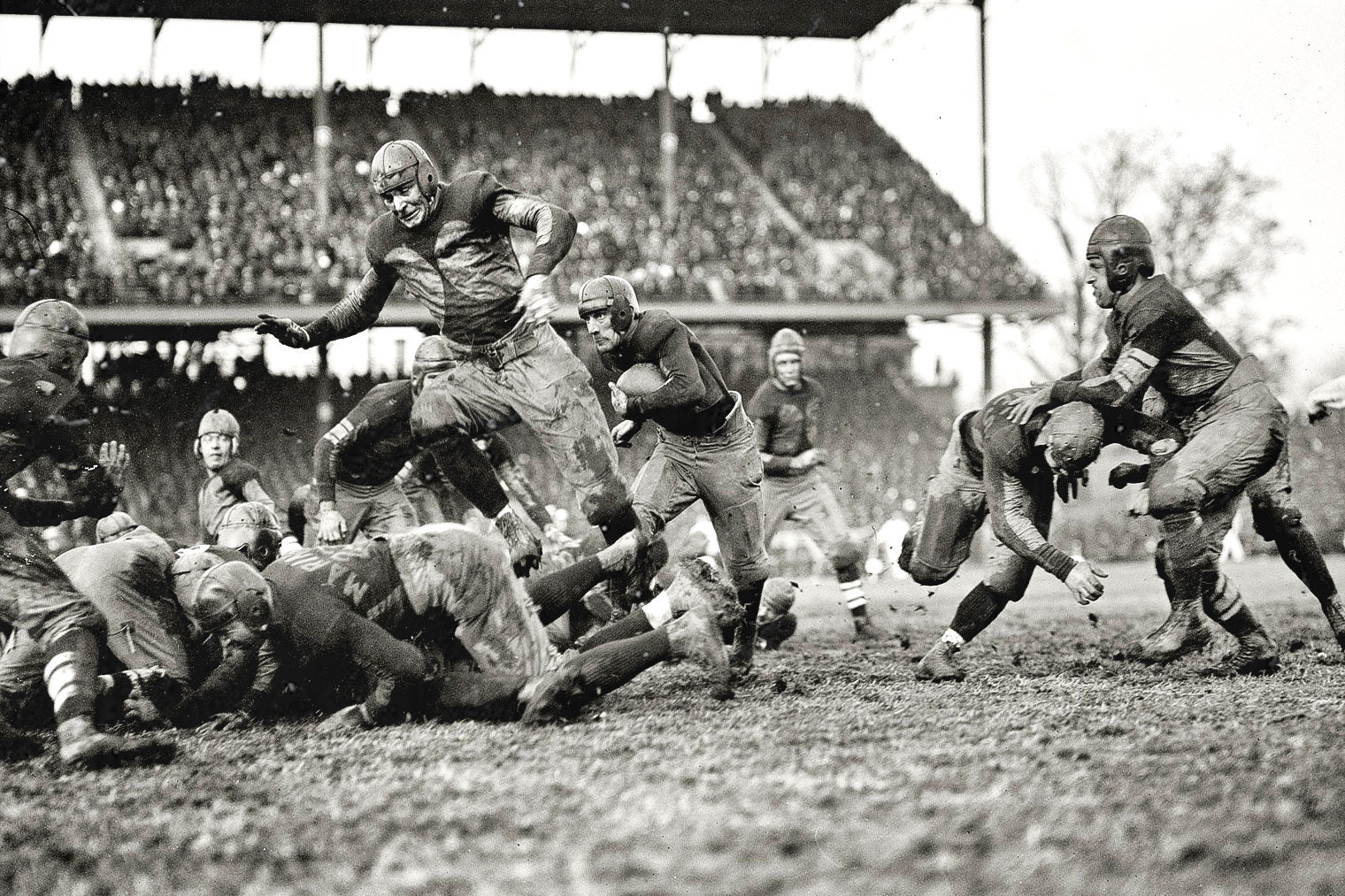How Football Became America's Sport
American football, or simply football, has established itself as more than just a sport in the United States. It has become deeply ingrained in the nation's culture, capturing the hearts and minds of millions of fans across the country. From its humble beginnings to its present-day dominance, the National Football League (NFL) has played a pivotal role in shaping this phenomenon. The Early Days of American Football Before the NFL emerged, American football underwent a series of changes and developments. The roots of the game can be traced back to the mid-19th century, where it started as a variation of English rugby. As the years went by, the sport gained popularity and began to evolve into what we now recognize as American football. During this time, football was primarily played by college teams and was considered a rough and brutal sport. The rules were still in their infancy, and there was no standardized way of playing the game. Each team had its own set of rules, leading to confusion and inconsistency on the field. However, as the sport grew in popularity, the need for a more organized and professional approach became apparent. It was during this time that the concept of a professional football league began to take shape. In 1920, the American Professional Football Association (APFA), later known as the NFL, was established. This marked a significant turning point in the history of American football and set the stage for the league's future success. The Birth of NFL The formation of the NFL brought together various teams from different parts of the country, providing them with a platform to compete at the highest level. The league's inaugural season featured just ten teams, but it quickly grew in size and stature over the following decades. One of the key figures in the early days of the NFL was Pete Rozelle, who became the league's commissioner in the 1960s. Under Rozelle's leadership, the NFL underwent a transformative period that paved the way for its rise to prominence. The introduction of television broadcasts and league-wide marketing strategies played a crucial role in increasing the NFL's fanbase and overall popularity. As the NFL gained more attention, it also faced challenges and controversies. The league had to navigate through labor disputes, player safety concerns, and issues related to diversity and inclusion. However, these challenges only served to make the NFL stronger and more resilient. The Evolution of the Game As the NFL continued to expand, the game itself underwent significant changes. Rules were modified to improve player safety and enhance the overall flow of the game. The introduction of innovations such as the forward pass and the adoption of instant replay technology added excitement and strategic depth to football matches. Additionally, the NFL embraced advancements in sports science and technology, leading to improved training methods, equipment, and player performance. The evolution of the game not only captivated fans but also attracted top athletes from other sports, further solidifying football's status as America's favorite pastime. Off the field, the NFL became a cultural phenomenon. Super Bowl Sunday became an unofficial national holiday, with millions of people tuning in to watch the game and the highly anticipated halftime show. The league's impact extended beyond sports, with football becoming a significant part of American culture and identity. Furthermore, the NFL's commitment to social causes and community outreach programs has made it a force for positive change. The league has used its platform to raise awareness about important issues, support charitable initiatives, and promote inclusivity and equality. In conclusion, the early days of American football laid the foundation for the NFL's success. From its humble beginnings as a variation of rugby to becoming a multi-billion dollar industry, football has come a long way. The NFL's continuous evolution and ability to adapt to changing times have ensured its enduring popularity and secured its place as one of the most beloved sports in America. The Rise of NFL Popularity While the NFL's success can be attributed to a variety of factors, two key elements have played a significant role: the media and the Super Bowl. The Role of Media and Broadcasting Television broadcasts revolutionized the way football reached audiences. With live games broadcasted across the country, fans could watch their favorite teams and players from the comfort of their homes. This accessibility helped the NFL carve a permanent place in American households. But it wasn't just the live broadcasts that propelled the NFL to new heights. The league also recognized the power of storytelling and created compelling narratives around teams and players. By highlighting the personal stories, triumphs, and struggles of athletes, the NFL engaged fans on a deeper level. This approach not only captivated existing fans but also attra

American football, or simply football, has established itself as more than just a sport in the United States. It has become deeply ingrained in the nation's culture, capturing the hearts and minds of millions of fans across the country. From its humble beginnings to its present-day dominance, the National Football League (NFL) has played a pivotal role in shaping this phenomenon.
The Early Days of American Football
Before the NFL emerged, American football underwent a series of changes and developments. The roots of the game can be traced back to the mid-19th century, where it started as a variation of English rugby. As the years went by, the sport gained popularity and began to evolve into what we now recognize as American football.
During this time, football was primarily played by college teams and was considered a rough and brutal sport. The rules were still in their infancy, and there was no standardized way of playing the game. Each team had its own set of rules, leading to confusion and inconsistency on the field.
However, as the sport grew in popularity, the need for a more organized and professional approach became apparent. It was during this time that the concept of a professional football league began to take shape. In 1920, the American Professional Football Association (APFA), later known as the NFL, was established. This marked a significant turning point in the history of American football and set the stage for the league's future success.
The Birth of NFL
The formation of the NFL brought together various teams from different parts of the country, providing them with a platform to compete at the highest level. The league's inaugural season featured just ten teams, but it quickly grew in size and stature over the following decades.
One of the key figures in the early days of the NFL was Pete Rozelle, who became the league's commissioner in the 1960s. Under Rozelle's leadership, the NFL underwent a transformative period that paved the way for its rise to prominence. The introduction of television broadcasts and league-wide marketing strategies played a crucial role in increasing the NFL's fanbase and overall popularity.
As the NFL gained more attention, it also faced challenges and controversies. The league had to navigate through labor disputes, player safety concerns, and issues related to diversity and inclusion. However, these challenges only served to make the NFL stronger and more resilient.
The Evolution of the Game
As the NFL continued to expand, the game itself underwent significant changes. Rules were modified to improve player safety and enhance the overall flow of the game. The introduction of innovations such as the forward pass and the adoption of instant replay technology added excitement and strategic depth to football matches.
Additionally, the NFL embraced advancements in sports science and technology, leading to improved training methods, equipment, and player performance. The evolution of the game not only captivated fans but also attracted top athletes from other sports, further solidifying football's status as America's favorite pastime.
Off the field, the NFL became a cultural phenomenon. Super Bowl Sunday became an unofficial national holiday, with millions of people tuning in to watch the game and the highly anticipated halftime show. The league's impact extended beyond sports, with football becoming a significant part of American culture and identity.
Furthermore, the NFL's commitment to social causes and community outreach programs has made it a force for positive change. The league has used its platform to raise awareness about important issues, support charitable initiatives, and promote inclusivity and equality.
In conclusion, the early days of American football laid the foundation for the NFL's success. From its humble beginnings as a variation of rugby to becoming a multi-billion dollar industry, football has come a long way. The NFL's continuous evolution and ability to adapt to changing times have ensured its enduring popularity and secured its place as one of the most beloved sports in America.
The Rise of NFL Popularity
While the NFL's success can be attributed to a variety of factors, two key elements have played a significant role: the media and the Super Bowl.
The Role of Media and Broadcasting
Television broadcasts revolutionized the way football reached audiences. With live games broadcasted across the country, fans could watch their favorite teams and players from the comfort of their homes. This accessibility helped the NFL carve a permanent place in American households.
But it wasn't just the live broadcasts that propelled the NFL to new heights. The league also recognized the power of storytelling and created compelling narratives around teams and players. By highlighting the personal stories, triumphs, and struggles of athletes, the NFL engaged fans on a deeper level. This approach not only captivated existing fans but also attracted new ones, as they became emotionally invested in the lives of their favorite players.
As technology advanced, so did the NFL's reach. The rise of cable and satellite television further expanded the league's audience, making it a staple in sports programming. Fans could now access a multitude of channels dedicated to football, providing in-depth analysis, behind-the-scenes footage, and exclusive interviews. This comprehensive coverage allowed fans to immerse themselves in the world of football, fostering a sense of belonging and community.
The Impact of Super Bowl
No discussion of the NFL's popularity would be complete without mentioning the Super Bowl. The championship game has evolved into a cultural phenomenon, transcending the realm of sports. Annually, millions of viewers gather around their screens, not only to watch the game but also to enjoy the halftime show and the commercials.
The Super Bowl has become an event that brings people together, regardless of their level of interest in football. It has become a tradition, a shared experience that extends beyond the game itself. Friends and families gather for Super Bowl parties, where they indulge in delicious snacks, engage in friendly banter, and eagerly anticipate the iconic halftime show.
Furthermore, the Super Bowl has become a platform for advertisers and sponsors to capture the attention of a massive audience. Companies invest millions of dollars in creating memorable commercials that will be talked about for years to come. These ads have become an integral part of the Super Bowl experience, with viewers eagerly awaiting the breaks to see what creative and entertaining advertisements will grace their screens.
Additionally, the halftime show has become a spectacle of its own. Renowned musicians and performers take the stage, delivering electrifying performances that captivate audiences worldwide. From iconic moments like Michael Jackson's unforgettable performance in 1993 to Beyoncé's show-stopping act in 2013, the halftime show has become a cultural event in its own right.
Overall, the Super Bowl has transformed into more than just a football game. It has become a celebration of American culture, a showcase of talent, and a platform for unity. Its immense popularity has undoubtedly contributed to the NFL's rise and enduring success.
NFL's Cultural Influence
The impact of the NFL extends far beyond the field and television screens. It has become intertwined with American identity and has left an indelible mark on pop culture. The National Football League (NFL) has become a cultural phenomenon, capturing the hearts and minds of millions of Americans.
NFL and American Identity
Football has become more than just a game; it has become a symbol of strength, toughness, and teamwork - attributes many Americans cherish. The values upheld by the sport align with the nation's ideals and have helped forge a unique sense of identity. The NFL has become a unifying force, bringing people from all walks of life together to support their favorite teams and players.
Throughout history, football has provided a platform for social and cultural unity. From the stirring national anthem performances before games to the heartfelt tributes given during halftime shows, the NFL has found ways to connect with fans on a profound emotional level. The sport has become a source of pride and patriotism, with fans proudly displaying their team colors and chanting in unison at stadiums across the country.
Not only does the NFL foster a sense of community among fans, but it also serves as a source of inspiration for aspiring athletes. Many young boys and girls dream of one day stepping onto the gridiron, emulating their favorite NFL stars and striving for greatness. The sport has become a beacon of hope and ambition, encouraging individuals to push their limits and pursue their dreams.
The NFL's Influence on Pop Culture
The NFL has infiltrated various aspects of popular culture, leaving an indelible mark on movies, music, fashion, and advertising. Athletes have become household names, and their impact extends far beyond the realm of sports. From iconic figures like Joe Montana and Jerry Rice to modern-day superstars like Tom Brady and Patrick Mahomes, NFL players have become cultural icons, admired for their skills and revered for their achievements.
Football-themed movies and TV shows have entertained audiences worldwide, capturing the intensity and drama of the sport. Films like "Remember the Titans" and "Friday Night Lights" have not only showcased the game itself but also explored the deeper themes of friendship, perseverance, and overcoming adversity. These stories have resonated with audiences, further cementing the NFL's place in popular culture.
Furthermore, the NFL's influence extends beyond entertainment and into the realm of fashion. Team merchandise has become fashionable attire, with fans proudly donning jerseys, hats, and accessories to show their support. The iconic team logos and colors have become synonymous with style and have transcended the boundaries of sports fandom.
In addition to its impact on entertainment and fashion, the NFL has also made significant contributions to philanthropy and community involvement. Many players and teams actively engage in charitable efforts, using their platform to make a positive impact in society. From organizing youth football camps to supporting various causes and foundations, the NFL has shown a commitment to giving back and making a difference.
In conclusion, the NFL's cultural influence cannot be overstated. It has become more than just a game; it is a symbol of American identity and a pillar of popular culture. From its ability to unite people from all walks of life to its impact on movies, fashion, and philanthropy, the NFL has left an indelible mark on society. As the league continues to evolve and grow, its cultural significance will undoubtedly continue to shape and inspire generations to come.
The Business Side of NFL
Behind the spectacle and excitement of football lies a robust business infrastructure that fuels the success of the NFL.
The Economic Impact of the NFL
The NFL generates billions of dollars annually, creating jobs and stimulating local economies. The league's revenue streams include ticket sales, merchandise, licensing agreements, and broadcasting rights. The Super Bowl alone generates tremendous economic activity, attracting visitors and showcasing host cities on a global stage.
The NFL's Marketing Strategies
The NFL's marketing strategies have played a pivotal role in its popularity. The league consistently seeks innovative ways to engage fans, both during games and between seasons. Marketing campaigns, social media presence, and interactive experiences have created a sense of connection and loyalty among fans.
The Future of NFL
Looking ahead, the NFL faces various challenges and opportunities as it continues to evolve and adapt to the ever-changing landscape of entertainment and technology.
Challenges and Opportunities
The NFL must navigate issues such as player safety, maintaining fan interest, and expanding its global reach. Addressing these challenges while seizing opportunities like emerging digital platforms and international markets will be crucial for the league's sustained success.
The NFL in the Digital Age
In an increasingly digital world, the NFL must embrace technology to enhance the fan experience. From virtual reality to fantasy sports, the league has already started exploring new avenues to engage with fans and bring the game to life beyond traditional broadcasts.
As technology continues to advance, the NFL will undoubtedly find innovative ways to grow and maintain its position as America's sport.
In conclusion, the NFL's journey from its early days to becoming America's sport has been a remarkable one. Through its cultural influence, business strategies, and ability to adapt, the NFL has cemented its status as a beloved institution. As the league looks to the future, it will continue to capture the imagination of fans and shape American sports culture for generations to come.






















